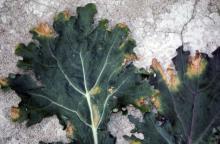Cause Xanthomonas campestris pv. campestris, a bacterium that overwinters in plant refuse for up to 2 years and is carried internally and externally on seed. The bacterium infects other crucifer crops and weeds. It may be spread in the field by water (rain, irrigation), insects, equipment, and animals. Many outbreaks can be attributed to disease spread in the seedbed.
When spread by water, bacteria enter water pores (hydathodes) at leaf margins or occasionally through insect or other mechanical injuries. From the leaf, the infection proceeds up and down the main stem and then becomes systemic. Disease development may stop in unfavorable weather only to resume when conditions are favorable. Optimum temperatures for development are 80°F to 86°F. Water in the form of dew, rain, or sprinkler irrigation is necessary for spread.
Symptoms Tissue at leaf margins becomes yellow; chlorosis progresses toward the leaf center, creating a V-shaped area with the base of the "V" at the leaf midrib. Veins in these areas become dark brown or black; when the leaf is held up to a strong light source, they show up as a black net. Vascular tissue of the main stem then becomes blackened. As the infection becomes systemic, symptoms (the same as those found from direct infection) may appear anywhere on the plant. Unilateral stunting of some leaves occurs. In infected seed, the first symptoms appear on cotyledons, which rapidly wilt and drop off; usually however, the infection has reached the stem and proceeds up.
Cultural control
- Use clean, pathogen-free seed. Seed from Western States generally is free from this disease.
- Use a 2-year rotation out of crucifers in production fields.
- Contaminated seed can be cleaned by hot water seed treatment of 122°F for 30 min.
- Control cruciferous weeds and insect pests.
Chemical control
- Actigard 50WG (Group P1) at 0.5 to 1 oz/A every 7 to 10 days for up to four (4) applications per season can suppress the development of black rot by inducing host-resistance pathways. Do not apply within 7 days of harvest. 12-hr reentry.
- Copper products (Group M1) are labeled for use.
- Badge SC at 0.5 to 1.8 pints/A on 7- to 10-day intervals. Preharvest interval is 0 days. 24-hr reentry for greenhouse use; 48-hr reentry for all other applications.
- Champ Formula 2 at 0.33 to 0.66 pint/A. Preharvest interval is 0 days. 48-hr reentry.
- Cuprofix Ultra 40 Disperss at 0.75 to 1.25 lb/A on 7- to 10-day intervals. 48-hr reentry.
- Kocide 2000 at 0.75 to 1.5 lb/A or Kocide 3000 at 0.5 to 0.75 lb/A on 7- to 10-day intervals. 48-hr reentry. O
- Regalia (Group P5) at 1 to 4 quarts/A plus another fungicide on 7- to 10-day intervals. Does not benefit from the addition of an adjuvant. Preharvest interval is 0 days. 4-hr reentry. O
Biological control Efficacy unknown in Oregon.
- Cease at 3 to 6 quarts in 100 gal water. For greenhouse plants only. Preharvest interval is 0 days. 4-hr reentry. O


